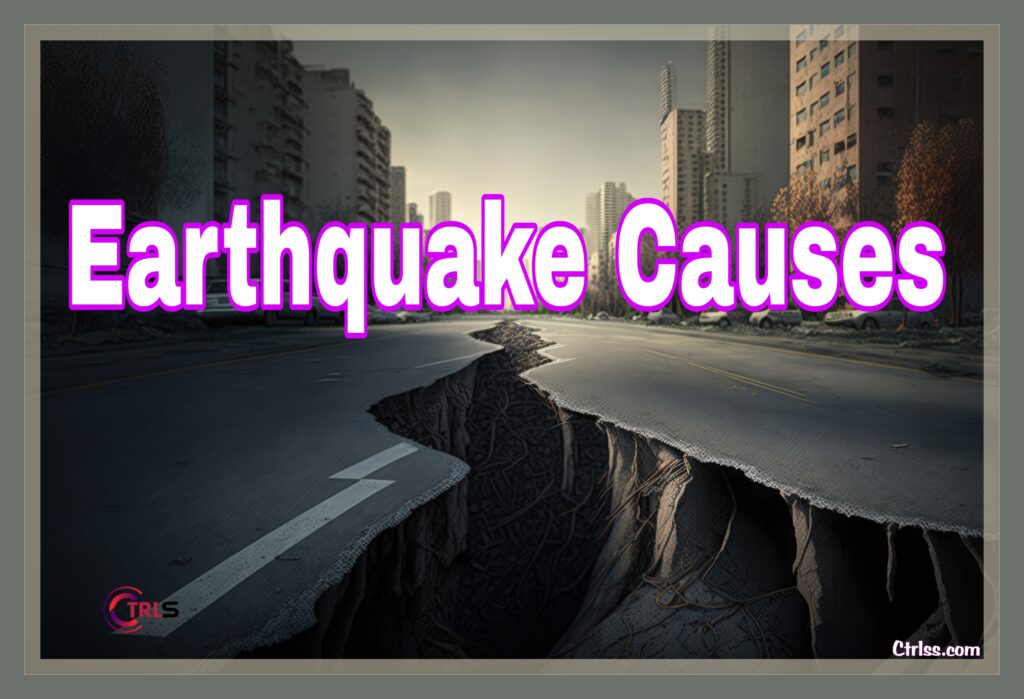what causes earthquakes ? What are the types of earthquakes?
what causes earthquakes ? causes of earthquakes – what causes an earthquake ? earthquake causes
Stop! Hold on tight because we’re about to embark on an awe-inspiring journey deep into the heart of Mother Earth’s seismic power. In this captivating exploration, we will unravel the enigmatic causes behind earthquakes, those earth-shaking phenomena that have both fascinated and terrified humanity for ages. So, fasten your seat belts and get ready to delve into the very foundations of our planet!

Understanding Earthquakes- Nature’s Fury Unleashed!
Before we plunge into the causes of earthquakes, let’s have a brief rendezvous with these unruly natural events. Picture yourself standing on solid ground, minding your own business, when suddenly the Earth beneath you starts to tremble. The ground dances beneath your feet, buildings sway like pendulums, and chaos ensues. This, my friend, is the sheer might of an earthquake, a reminder of how infinitesimally small we are in the face of nature’s raw power ” causes of earthquakes ” .
Tectonic Plates: The Titans Beneath Our Feet
To comprehend earthquake causes, we must first acquaint ourselves with the colossal forces at play beneath our very feet. Enter the stage, the protagonists of this seismic saga: tectonic plates. These gargantuan slabs of Earth’s crust float above a layer of molten rock known as the asthenosphere. Like restless giants, these plates are in constant motion, albeit at an imperceptible pace. But when they collide, slip, or grind against each other, seismic waves are unleashed, giving birth to earthquakes.
>> Earthquake Fact.
The Faulty Culprits- Unveiling Fault Lines
If tectonic plates are the actors, then fault lines are the stage where the drama unfolds. Fault lines are the fractures in the Earth’s crust where these behemoth plates meet. When the accumulated stress along these fault lines exceeds the strength of the rocks holding them together, seismic energy is released, resulting in an earthquake. These geological fault lines are the troublemakers responsible for the majority of earthquakes around the globe.
What are the types of earthquakes?
- 1. Tectonic Earthquakes: The Main Event
- 2. Volcanic Earthquakes: Fiery Tremors
- 3. Induced Earthquakes: Man-made Quakes
Exploring Different Types of Earthquakes: Not all earthquakes are created equal. They come in different flavors, each with its distinct characteristics and causes. Let’s take a whirlwind tour through the seismic landscape and uncover the secrets behind some of the most common types of earthquakes:
1. Tectonic Earthquakes: The Main Event
Picture a colossal clash between two tectonic plates, where neither is willing to yield an inch. When the pent-up energy becomes too much to contain, a tectonic earthquake occurs. These earthquakes are the heavyweights, the main event, and they often make the headlines. The sheer power unleashed during these seismic battles can reshape landscapes and leave lasting scars on the Earth’s surface.
2. Volcanic Earthquakes: Fiery Tremors
Volcanoes, the majestic yet fiery giants, are not only known for their eruptive splendor but also their seismic rumblings. When molten rock, or magma, rises within the Earth’s crust, it can cause volcanic earthquakes. These tremors are like a prelude to the volcanic symphony, signaling the movement of magma and the stirring of the sleeping giants. Volcanic earthquakes serve as a reminder of the turbulent forces lurking beneath the Earth’s surface.
3. Induced Earthquakes: Man-made Quakes
Nature isn’t the sole conductor of earthquakes; we humans can also leave our mark on the seismic scorecard. Certain human activities, such as mining, reservoir-induced seismicity, and hydraulic fracturing (commonly known as “fracking”), can induce earthquakes. While these induced earthquakes are generally of lower magnitude, they remind us of our capacity to inadvertently awaken the dormant seismic energies hidden within the Earth.
What are the causes of earthquakes?
- Tectonic Plate Movements.
- Subduction Zones.
- Faults and Fault Lines.
- Volcanic Activity.
- Human Activity.
Peering into Earth’s Core: The Quest for Answers-Earthquake Causes: As we dig deeper into the Earth’s core, the causes of earthquakes become increasingly intertwined with the complex dance of geology, physics, and time. Scientists and researchers are constantly pushing the boundaries of knowledge, striving to unravel the mysteries of seismic activity. By meticulously studying seismic waves, examining fault lines, and monitoring tectonic plate movements, they piece together the puzzle of earthquake causality, one fragment at a time.
Earthquakes are herbal phenomena that may be each awe-inspiring and devastating. They arise while there may be a unexpected launch of strength with inside the Earth’s crust, ensuing in seismic waves that shake the ground. The causes of earthquakes can be attributed to several factors, and understanding them is crucial for mitigating their impact and ensuring safety.
What are the causes of earthquakes?
Tectonic Plate Movements:
The number one purpose of maximum earthquakes is the motion and interplay of tectonic plates. The Earth’s floor is split into numerous big portions referred to as plates, which waft at the semi-fluid layer below them. Where these plates meet, they can either collide (convergent boundary), separate (divergent boundary), or slide past each other (transform boundary). The stress and pressure that build up along these plate boundaries over time can lead to earthquakes when they are released suddenly.
Subduction Zones:
One of the most significant sources of powerful earthquakes is subduction zones. Subduction occurs when one tectonic plate is forced underneath another plate into the Earth’s mantle. As the subducting plate sinks, it can become locked with the overriding plate, causing immense stress to build up. When this stress is finally released, it can trigger a large earthquake.
Faults and Fault Lines:
Faults are fractures or cracks in the Earth’s crust where movement occurs. Earthquakes commonly happen along fault lines, which are the visible traces of faults on the Earth’s surface. When stress accumulates along a fault line and exceeds its strength, it can result in an earthquake. Examples of well-known fault lines include the San Andreas Fault in California and the Ring of Fire in the Pacific Ocean.
Volcanic Activity:
Volcanic eruptions also can motive earthquakes. As magma rises to the surface, it can create pressure and deformation in the surrounding rock, leading to small to moderate earthquakes known as volcanic earthquakes. Additionally, the collapse of volcanic structures or the movement of magma underground can generate larger volcanic earthquakes.
Human Activity:
While most earthquakes occur naturally, certain human activities can induce seismic events. Activities such as mining, hydraulic fracturing (fracking), and the filling of large reservoirs behind dams can contribute to induced earthquakes. These earthquakes are typically of smaller magnitudes but can still cause damage and pose a risk in populated areas.
Understanding the causes of earthquakes is crucial for monitoring seismic activity, assessing risks, and developing strategies for disaster preparedness and response. Earthquake-prone regions around the world implement monitoring systems, such as seismographs and GPS, to detect and measure seismic activity. This information helps scientists and authorities provide early warnings, improve building codes, and develop effective emergency plans to minimize the impact of earthquakes on communities.
In conclusion:
Earthquakes are primarily caused by the movement of tectonic plates along fault lines. Subduction zones, fault activity, volcanic processes, and human-induced factors can all contribute to the occurrence of earthquakes. By studying and understanding these causes, we can work towards better preparedness and resilience in earthquake-prone regions, ensuring the safety and well-being of communities at risk.
Thanks for reading!



